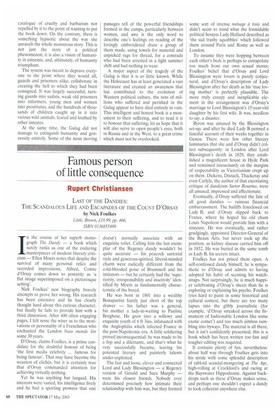Famous person of little consequence
Rupert Christiansen
LAST OF THE DANDIES: THE SCANDALOUS LIFE AND ESCAPADES OF THE COUNT D'ORSAY by Nick Foulkes Little, Brown, £18.99, pp. 466. ISBN 0136855499 In the course of her superb monograph The Dandy — a book which surely ranks as one of the enduring masterpieces of modern literary criticism — Ellen Moers notes that despite the survival of many personal relics and recorded impressions, Alfred, Comte d'Orsay comes down to posterity as 'a flat image superimposed on a picturesque setting'.
Nick Foulkes' new biography bravely attempts to prove her wrong. His research has been extensive and he has clearly thought hard about this curious character, but finally he fails to provide him with a third dimension. After 400 often engaging pages, I felt none the wiser as to the motivations or personality of a Frenchman who enchanted the London beau monde for some 30 years.
D'Orsay, claims Foulkes, is a prime candidate for the doubtful honour of being 'the first media celebrity ... famous for being famous'. That may have become the weariest of clichés, but it is certainly true that d'Orsay commanded attention for achieving virtually nothing.
Yet he was anything but languid. His interests were varied, his intelligence lively and he had a sporting prowess that one doesn't normally associate with an exquisite toilet. Calling him the last exemplar of the Regency dandy wouldn't be quite accurate — his peacock sartorial style and generous-spirited, liberal-minded charm were radically different from the cold-blooded poise of Brummell and his imitators — but he certainly had the 'superiority, irresponsibility and inactivity' identified by Moers as fundamentally characteristic of the breed.
He was born in 1801 into a wealthy Bonapartist family just short of the top drawer — his father was a general, his mother a lady-in-waiting to Pauline Borghese. He grew into a willowy and exquisite youth of 6 ft 3ins, infatuated with the Anglophilia which infected France in the post-Napoleonic era. A little soldiering proved inconsequential: he was made to be a fop and a dilettante, and that's what he very successfully became, leaving his potential literary and painterly talents under-exploited.
The fast and loose, clever and connected Lord and Lady Blessington — a Regency version of Gerald and Sara Murphy — were his closest friends. Nobody ever determined precisely how intimate their relationship with him was, but they formed
some sort of intense menage a trots and didn't seem to mind what the formidable political hostess Lady Holland described as 'the sad trashy squabbles' which followed them around Paris and Rome as well as London.
To assume they were hopping between each other's beds is perhaps to extrapolate too much from our own sexual mores: Foulkes' belief that d'Orsay and Lord Blessington were lovers is purely conjectural, and d'Orsay's description of Lady Blessington after her death as his 'true loving mother' is perfectly plausible. The more truly creepy and inexplicable element in the arrangement was d'Orsay's marriage to Lord Blessington's 15-year-old daughter by his first wife. It was, needless to say, a disaster.
Byron was amused by the Blessington set-up, and after he died Lady B penned a fanciful account of their weeks together in Genoa. There were few other literary luminaries that she and d'Orsay didn't collect subsequently: in London after Lord Blessington's death in 1829, they established a magnificent house in Hyde Park and remained insouciantly on the margins of respectability as Victorianism crept up on them. Dickens, Disraeli, Thackeray and even Carlyle, the author of that excoriating critique of dandyism Sartor Resartus, were all amused, impressed and affectionate.
Eventually, d'Orsay suffered the fate of all good dandies — ruinous financial embarrassment. The bailiffs foreclosed on Lady B, and d'Orsay slipped back to France, where he hoped his old chum Louis Napoleon would provide him with a sinecure. He was eventually, and rather grudgingly, appointed Director-General of the Beaux Arts, but never took up the position, as kidney disease carried him off in 1852. He was buried in the same tomb as Lady B, his secrets intact.
Foulkes has not prised them open. A self-confessed dandy himself, he is sympathetic to d'Orsay and admits to having adopted his habit of scenting his watchstraps. Not surprisingly, he is much happier celebrating d'Orsay's sheen than he is exploring or explaining his psyche. Foulkes tries hard to paint in some historical and cultural context, but there are too many lapses into the glibly journalistic (for example, `d'Orsay streaked across the firmament of fashionable London like some exotic comet') and too much aimless rambling into byways. The material is all there, but it isn't confidently presented; this is a book which has been written too fast and tougher editing was required.
It contains plenty of fun, nevertheless: about half way through Foulkes gets into his stride with some splendid description of tabloid scandal-mongering at The Age, high-rolling at Crockford's and racing at the Bayswater Hippodrome. Against backdrops such as these d'Orsay makes sense, and perhaps one shouldn't expect a dandy to look coherent anywhere else.


































































































 Previous page
Previous page